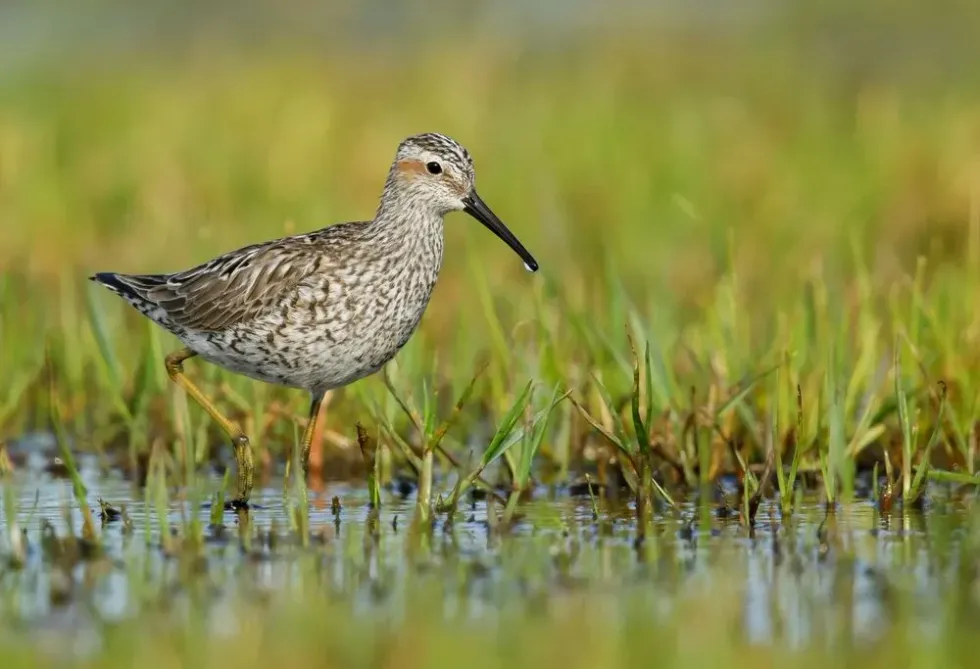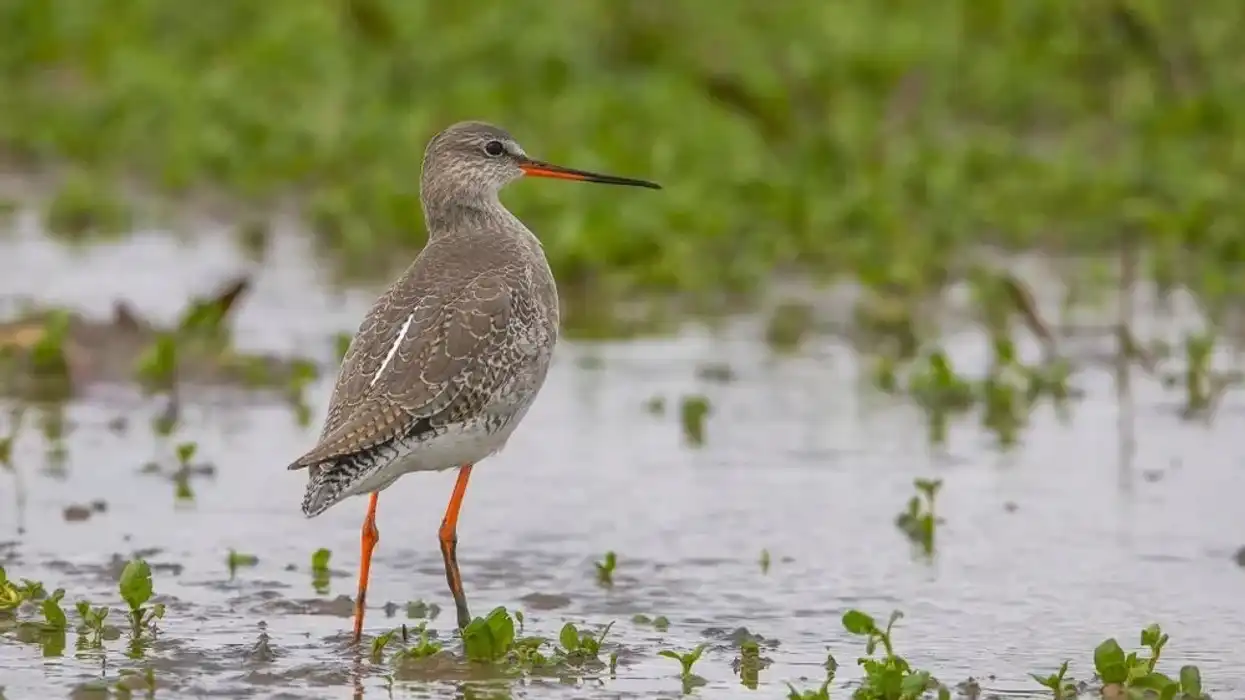The stilt sandpiper (Calidris himantopus) is a shorebird species belonging to the sandpiper family of birds (which consists of the common redshank, red phalarope, Asian dowitcher, and others). It is a medium-sized bird and their bodies are different shades of chestnut and brown during different stages of their lifetimes.
Their long bills which are slightly curved also stand out. Stilt sandpipers hail mainly from North America, and the Arctic tundra, and these stilt sandpipers fly to northern parts of South America with their flocks in search of warmer weather.
They live here on the shores of freshwater bodies. During winter, the sandpiper will forage more at night as they feed by touch.
They are often seen feeding on food such as insects, larvae, beetles, and even seeds. Frequent hunting and global climate change are having a noticeable impact on their population and habitat.
Find out more about the stilt sandpiper here, or learn about other birds like the Arctic tern and the Caspian tern.
Stilt Sandpiper Interesting Facts
What type of animal is a stilt sandpiper?
The stilt sandpiper is a bird belonging to the order Charadriiformes, family Scolopacidae, and genus Calidris.
What class of animal does a stilt sandpiper belong to?
The stilt sandpiper belongs to the bird (Aves) class of animals.
How many stilt sandpipers are there in the world?
The exact number of birds of the stilt sandpiper species left in the world is unknown.
Where does a stilt sandpiper live?
The stilt sandpiper species lives near freshwater bodies such as flooded fields and pastures, ponds, impoundments, and marshes.
What is a stilt sandpiper's habitat?
In the summer, it lives in the Arctic tundra of the North American continent, and in harsh winters, these birds migrate to northern parts of South America. It is a shorebird, so it survives near bodies of fresh water. These include flooded fields and pastures, ponds, impoundments, and marshes, as well as any place rainwater has made pools.
Who do stilt sandpipers live with?
They travel south for the winter in flocks, and also forage and feed in flocks of their species. They are also known to roost together with other similar species of shorebirds such as dowitchers and lesser yellowlegs.
How long does a stilt sandpiper live?
An average stilt sandpiper may live for three to five years.
How do they reproduce?
Stilt sandpipers reproduce by mating and laying eggs. Males and females mate for life and females lay around four eggs in their breeding season (in June) which are incubated by both males and females. The eggs hatch within seven days.
What is their conservation status?
The conservation status of the stilt sandpiper is currently Least Concern.
Stilt Sandpiper Fun Facts
What do stilt sandpipers look like?
Stilt sandpipers are moderate-sized shorebirds with a slightly pudgy belly, a black, slightly curved bill, long legs, narrow wings, and a thin neck. The head of the stilt sandpiper features a dull line, and its cheek and crown are both chestnut-colored.
During its basic plumage, its underparts look white, its back is gray-brown and its chest is grayish. During its breeding plumage, its feathers are dark brown, (more so in males than females). Its legs are greenish-yellow and its irises are dark brown.

*Please note that this is an image of a sandpiper, not a stilt sandpiper specifically. If you have an image of a stilt sandpiper, please let us know at hello@kidadl.com
How cute are they?
Their prominent-looking breeding plumage, yellow-green legs, slightly pudgy bellies, and long bills make them cute-looking birds!
How do they communicate?
The stilt sandpiper species communicates through various vocalizations and sounds during different stages of their lives. A chick makes a repetitive 'peep' sound before being born and, after hatching, its notes are louder and harsher. Adults of the species give out mating calls during the breeding season, with the male's song being more melodious than the female's.
How big is a stilt sandpiper?
The wings of stilt sandpiper birds have a wingspan of 15-16 in (38–41 cm), and they are 7.9-9.1 in (20–23 cm) tall. They are seven to eight times smaller than a swan.
How fast can a stilt sandpiper fly?
The speed of a stilt sandpiper in flight ranges from 40-45 mph (64-72 kph). This flight speed can be maintained over a long distance and this is important because the stilt sandpiper is essentially a migratory bird with changing habitats.
These habitats change from summer to winter. The Arctic tundra is swapped for warmer habitats of South America mainly for survival during harsh winters.
How much does a stilt sandpiper weigh?
A stilt sandpiper weighs around 1.8-2.5 oz (50-70 g).
What are the male and female names of the species?
There are no specific names for male and female stilt sandpipers.
What would you call a baby stilt sandpiper?
Much like other birds, a baby stilt sandpiper is called a chick.
What do they eat?
Stilt sandpipers are known for feeding on insect larvae, beetles, and snails.
Are they aggressive?
No, they are not particularly aggressive birds.
Would they make a good pet?
No, a stilt sandpiper would not make a good pet. This is a wild bird that lives, eats, and breeds peacefully with its species and others.
Did you know...
Since the stilt sandpiper breeds in the Arctic tundra of North America, its range map includes the countries of America and Canada. To avoid the harsh weather, there is a large migration of these birds to warmer parts of South America in winter.
Outside this range map, some long-distance traveling stilt sandpipers are also found in Europe, Australia, and Japan.
The stilt sandpiper belongs to the order Charadriiformes, family Scolopacidae, and genus Calidris.
According to the Cornell Lab of Ornithology, hunting affects the populations and habitat of North American stilt sandpipers. The Cornell Lab of Ornithology also states that the foraging territory of these birds may extend up to 5 miles (8 km) from their incubation site.
Another bird species that is similar to stilt sandpiper birds are lesser yellowlegs. Lesser yellowlegs are a bird species also belonging to the shorebird family. The stilt sandpiper's 'tu-tu' flight song is similar to that of the yellowlegs.
Any description of these birds has to mention their long bill, a trait shared by many other birds, including dowitchers.
When it comes to the identification of a stilt sandpiper you have to look out for different things for birds of different ages. For example, juveniles have long greenish-yellow legs, and their bodies look scaly.
Juveniles also display their white rump patch during flight. Identification of breeding adults is easy, with them displaying heavily barred underparts, blotched backs, and chestnut cheeks. In contrast, the stilt sandpiper juvenile has white-brown underparts, and it is also known to get belly-deep in freshwater.
According to the Field Guides of North America, climate change may reshape the stilt sandpiper range, mainly in the northern parts of Canada closest to the Arctic Circle, with some fearing a complete loss of range in Churchill, Manitoba, and Fort Severn, Ontario if the temperatures rise by 37.4 F (3 C).
It is estimated that 89% of this migrant bird's range will be lost even if the temperatures rise by 34.7 F (1.5 C).
This makes conservation efforts important!
What are the breeding behaviors of a stilt sandpiper?
To get a female's attention, a male glides over her territory in 'V's' while singing a song. He plummets towards the female and raises his wings.
Their nesting site is low and surrounded by water and they build a nest in a shallow hole in the ground. After mating, a clutch size of four eggs is laid by the female, with both parents incubating in turns (males during the day and females at night) for about 20 days.
What are the other similar birds often confused with stilt sandpipers?
Similar species of birds often confused with stilt sandpipers are dowitchers, red-backed sandpipers, the short-billed dowitcher, the common redshank, the semipalmated sandpiper, and the marbled godwit.
Here at Kidadl, we have carefully created lots of interesting family-friendly animal facts for everyone to discover! Learn more about some other birds including the glossy ibis, or the Indian roller.
You can even occupy yourself at home by drawing one on our Stilt Sandpiper coloring pages.









